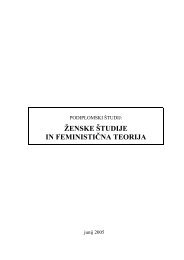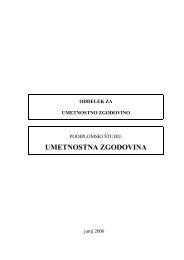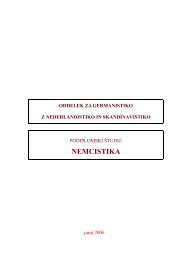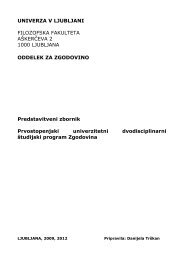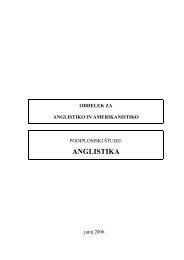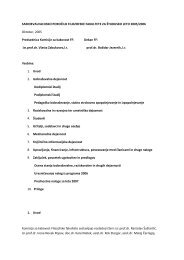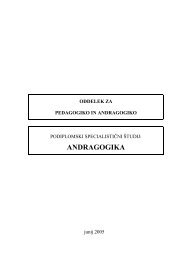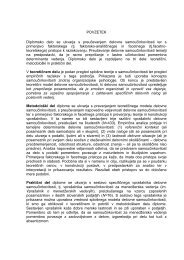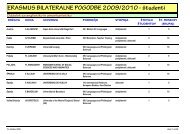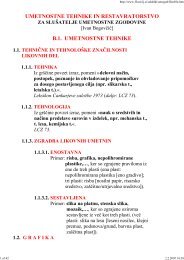B_solo_zgibanke male new_1 - Filozofska fakulteta
B_solo_zgibanke male new_1 - Filozofska fakulteta
B_solo_zgibanke male new_1 - Filozofska fakulteta
You also want an ePaper? Increase the reach of your titles
YUMPU automatically turns print PDFs into web optimized ePapers that Google loves.
3. attitUDiNaL aPPROaCHeS tO tHe StUDy OF iNtONatiON<br />
O’Connor and arnold (1975) have developed a list of ten intonation patterns or<br />
tunes, as they call them. they vary in the degree of the pitch range they cover: some<br />
have a very broad pitch range, others have a narrower pitch range; in some the pitch<br />
movement is first rising and then falling, while others begin with a falling pitch<br />
movement which is later followed by the fall-rise tone. each of the tunes has a<br />
number of meanings which often depend on the type of a syntactical structure they<br />
are used in, as well as on the context in which they occur. the main criticism of<br />
O’Connor and arnold’s model was that the intonation meanings are as diverse as<br />
the number and the types of situations they can occur in.<br />
One of the first linguists to have shown interest in the intonation of the english<br />
language was Pike (1945). He developed a very comprehensive description in which<br />
he was also interested in intonation meanings and the speaker’s attitude to the<br />
message as well as to the addressee. His description is based on four pitch levels and<br />
four tones which may begin on one and end on the other pitch level. Pike’s<br />
intonation lexicon thus consists of 29 contours. in spite of the fact that Pike’s model<br />
is even more comprehensive in the number of patterns than O’Connor and arnold’s,<br />
it is much less confusing in labelling the meanings. the only problem is that he does<br />
not make a distinction between the syntactic structure of an utterance and its<br />
attitudinal meaning. ‘Non-finality’ and ‘question’ are certainly not attitudes.<br />
it seems almost impossible to develop a comprehensive intonation model which<br />
would account for a great variety of attitudinal meanings in a relatively simple and<br />
straightforward way. However, tench (1996: 136) managed to summarize the main<br />
attitudinal meanings of tones and pre-tonic segments in english.<br />
He distinguishes four tones (the fall, the rise, the fall-rise and the rise-fall) which<br />
can be neutral or marked depending on the informational and communicative<br />
intentions of the speaker, as well as the syntactic structure of the utterance. the<br />
attitudinal markedness of the tones is expressed by the height of the pitch range.<br />
thus the fall and the rise pronounced in high pitch sound ‘strong’ and ‘intense’,<br />
whereas when pronounced in low pitch they sound ‘mild’ and ‘non-committal’. if the<br />
rise-fall is pronounced high in pitch, it sounds even ‘more intense’ and ‘stronger’<br />
than the high fall, but when it is pronounced with low pitch it sounds ‘intensified<br />
and emotional’. the neutral form for the fall-rise is high pitch, while an attitudinally<br />
marked form is low with a ‘strong contrastive and implicational’ meaning.<br />
tench (1996: 137) also summarized the pre-nuclear pitch patterns, the so-called<br />
‘heads’. there are six heads: high, low, descending, ascending, stepping and<br />
glissando. they do not have their independent meanings but are closely associated<br />
with the tones. thus the combinations of a high head before a rise and a low head<br />
before a fall are used primarily to highlight the immediately following information;<br />
the combinations of a high head before a fall and a low head before a rise express<br />
insistence or involvement on the part of the speaker; the combinations of<br />
descending and ascending heads with any tone sound warm and expecting<br />
218



